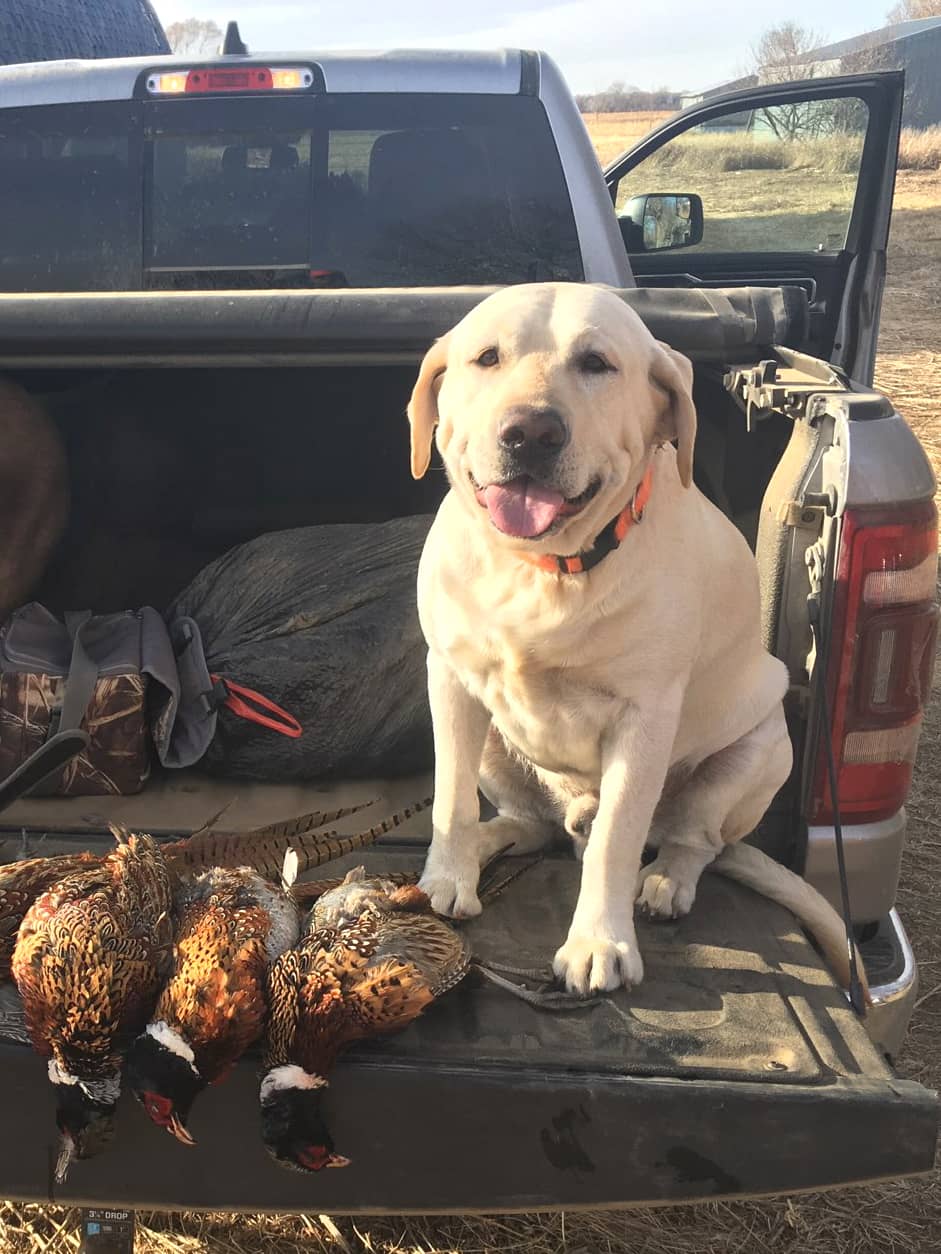
Tale Gate. The stories and traits of dogs in the past blur into the present as the author’s lab, Ole, stands proudly over his trio of roosters. Simonson Photo.
By Nick Simonson
It isn’t fair to compare hunting dogs, not among friends or fellow hunters, or even among the different ones owned throughout a person’s lifetime. It isn’t fair, but we do it anyway.
I was spoiled with my first lab, Gunnar, who lived for 15 and a half years and hunted for 13 of them. He was an adept field companion who trained me more than I trained him. He’d creep up on a scent line and drop his head so low to the ground when he went on point that he nearly disappeared into the grass. His right paw would cock, and his tail would bend at an angle making him look like a pent-up spring ready to go off, and he would on command.
He was lean, and when in perfect fall shape came in at just under 75 pounds, able to weave his way through the tightest brush and around and under matted cattails in a slough to find birds without making a sound. In late season, he could take on the deepest cover and barely rattle the frosting of snow up until a bird exploded out from the white-and-brown rooftop.
In the overlap of Gunnar’s final non-hunting years, I purchased Ole. Hoping to find a smaller, slender lab, I knew my second dog would be the opposite as I inspected the litter at the farm in central Minnesota. Tripping over the large paws the pup had yet to grow into, he was the only dog in the group that would come to my call and whistle, and I knew – or perhaps feared – that he would be twice as big as Gunnar. I hoped that with his size, he would be at least half the hunter his predecessor was, and that would be good enough.
Ole did grow into those paws, and regularly hits triple digits on the veterinarian’s scale at our late summer checkups. Far from slim, he’s not fat, but heavily muscled under a layer of insulation and he’s often an unintentional wrecking ball wrapped in yellow fur rumbling around the house and yard, at times incapable of understanding his own strength. Unlike Gunnar, there’s no stealthy weaving or snaking through the branches and bases of a shelterbelt for Ole. He bounds head-first with a crack and a smash of wood like a Hollywood stuntman being thrown through a saloon wall in an old western, and he keeps coming back for more.
He’s made it on ten-mile summer runs around the lake with me, and even when he slows down later in the hunting day, he’s still in motion, even if it’s slow motion, until the scent of a nearby rooster sets him on the chase. As for sneaking through the cattails, I’d be better off with a tow rope to ride the wake he makes through the vegetation. There’s no guessing where Ole is as the thick stuff parts like the Red Sea around his thundering pursuit.
Ole’s points lack the flair of Gunnar’s. There’s no bend in the leg and no angle in the tail. Just a block of blonde marble standing still over a holding bird. The intensity is the same, and both methods get the job done in setting up the shot. But being about 6 inches taller and 25 pounds heavier, Ole hardly disappears low into the grasses that surround his quarry, and has always been more than visible on his points. That is until our first few minutes in the field for an action-packed pheasant hunt last week.
Coming off the drain around a harvested cornfield, Ole picked up the trail of two far flushing roosters that had made a hasty exit, and I watched as he narrowed the gap through the grassy stretch. About halfway to their departure point, he swung back and caught fresh scent on the northwest breeze.
Suddenly, he locked up, dropping low to the ground, front legs bent and nose buried in the tiniest clump of grass. He seemingly made his massive body disappear into the space around him, like some amazing Copperfield stunt, though it could have been fueled by my adrenaline rising and my quick click of the safety to ready for the coming flush. Afterall, a magician’s best friend is a distracted audience.
I had flashbacks to the hundreds of points I had seen from Gunnar and gave Ole the “Go!” command. The rooster broke low just inches from my dog’s nose and angled up and out, and my second barrel caught him and brought him down for the retrieve. Amazed at the temporary shift in the style of his point – and we’ve had a handful already this season, and dozens in the last three years – I chalked it up as a fluke and shook off the idea that for one odd instant, he channeled the aura of my previous lab who had died exactly a year and a day before. It was likely a trick of the eye in the blowing grasses, or a setup of the mind with my previous hunting partner in my thoughts, or just the excitement of the opportunity to come.
Save for perhaps his first, it was Ole’s best point and certainly the most memorable in my mind, as for a second, 15 years of trailing two dogs merged into one moment and I struggled to find a difference in ability between the two…in our outdoors.
